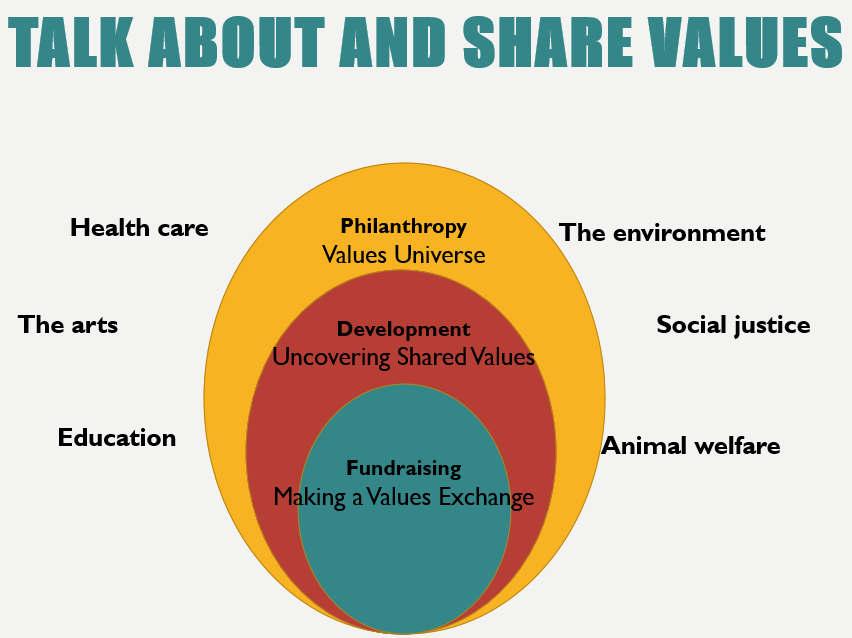 What motivates someone to make a major philanthropic gift?
What motivates someone to make a major philanthropic gift?
Generally it takes one or more meaningful conversations with a donor who (you hope!) may contemplate a gift to your organization. At some point you’ll be ready to make them an offer you hope they won’t be able to refuse. But how do you develop their interest and passion to the point where they’re willing and ready to enact them? Today I’m suggesting it’s actually pretty simple, as long as you truly understand the process of what the nonprofit sector has come to call “development.”
To get folks to “YES” you simply need to learn the language of gift planning!
It’s not just about HOW people give, but WHY.
Planning is the operative word. Alas, when many folks talk about ‘planned giving’ it’s a term that’s come to mean giving vehicles. Often it’s just about deferred giving vehicles. Most donors don’t think this way. Rather, they consider how they want to help. They concern themselves with the best ways to enact their values. This may mean an outright gift today or a deferred gift tomorrow. Or both. Form follows function. So thinking in terms of gift vehicles is a decidedly non-donor-centric way of framing things.
People making bequests or gifts in trust often visit legal and financial advisors. So we think of this more as “planning” mode. And we ask “planned gift officers” to work with these folks. This isn’t wrong, but it’s not as right as it could be if you approached the donor’s giving decision more expansively.
In othe words, major gift officers are also planned giving officers.
Anyone who contemplates a major, or stretch, outright gift plans ahead.
No one gets up one morning and decides spontaneously to give away $100,000.
Or let’s just stipulate it’s relatively rare.
Rather, would-be philanthropists consider how making a particular gift at a particular point in time may match their values and help them accomplish their objectives, personal and philanthropic.
It’s seldom a spur of the moment action.
For purposes of this gift planning article, let’s consider your audience to be prospective major (outright) and legacy (deferred) gift donors.
Let’s try an experiment.
Think of one donor with whom you’d like to have a deeper conversation about making a meaningful gift.
Thinking?
I’ll wait.
Got someone?
Okay.
Picture them in a place where you’d like to meet them.
Is it their home? Their office? Your office? A café? On a Zoom or phone call?
Think about what’s realistic with this person, and what they might prefer.
Make sure this is an opportunity to talk one-to-one. And not a group setting, like an event, volunteer activity or committee meeting. Those conversations can be useful, but they’re seldom deep.
Got an idea of who you’re speaking with and where you both are?
Good.
We’ll get back to this prospect in a moment.
First, let’s consider the language donors speak: philanthropy
The literal translation of the word from the Greek – love of humankind— is how I most prefer to characterize folks who take a “voluntary action for the public good.” This latter phrase is how Robert Payton, the first full-time Director of the Center for Philanthropy at Indiana University, defined philanthropy. He saw philanthropists as people with a spiritual (not necessarily religious) calling. Philanthropy seen as a special kind of occupation — a vocation.
Philanthropy isn’t incidental; it’s part of these folks’ essence. And it’s done absent coercion. For the benefit of the good.
Philanthropists are passionate lovers.
And for them to feel and express their love, it’s your job to connect them with their passions by speaking the language of love. Or, more specifically, to talk with them about their most beloved values.
Fundamentally, philanthropy is about values.
Philanthropy begins with the values your organization enacts. Be they animal welfare, human services, health and wellness, education, science, the environment, the arts, social justice or any number of causes.
The values you enact will draw folks who share these values like a magnet.

There’s an entire universe of values out there (several examples depicted). Lots and lots and lots of magnets. Because there are so many of them, however, the force they exert on any one individual is relatively weak.
That’s where you come in! To point folks in the right direction; then fan the flames.
Enter the process we’ve come to call “development.”
It’s a box full of strategies designed to uncover folks who share the values you enact.
For new prospects and donors who give below your major gift amount, many of your strategies will be more ‘marketing’ (e.g., website, SEO, newsletters, advertising, social media, other publications; free events) less ‘fundraising’ (e.g., offline and online appeal approaches or solicitation events).
I strongly encourage you not to silo the two functions (or departments). I argue they’re the same thing for nonprofit purposes. At the least, they go together like peanut butter and jelly. Often, they’re designed to accomplish the very same outcomes – so why confuse your donors by having different messages bombarding them from different places and perspectives?
It’s essentially all about creating positive customer experiences. Marketing and fundraising staff should be doing it together, not in silos.
“The heads of development and marketing have to accept that they are oxen pulling the same wagon, a wagon labeled ‘increasing community support’.”
— Tom Ahern, Leading authority on donor communications
Begin by identifying the communication channels where you’re most likely to find folks who share your values. Coordinate your content marketing and fundraising messaging across multiple channels, targetting the best audiences for particular messages and mediums. See what ensues.
Donors who passionately value what your organization does are your most likely partners. When you uncover these folks, it’s time to begin the conversation.
Your job is to make the match between what donors care about and what you do.
This is a time when you truly must connect. When you have a conversation with likely donor prospects, you need to speak the language of philanthropy. The language of love. There are lots of open-ended questions you can ask folks to draw them out and let them share their own powerful stories. Listen with love and attention, and reflect back to them what you hear. Ask “what else do you have to say about this?” Give them the floor to talk about their own interests, experiences, values and passions. You want them to feel in a powerful, generous and loving mood.
One of my favorite questions to ask prospective major donors is about the legacy they’d like to leave.
What would they like for their children, grandchildren, community, country and world? Ask open-ended questions about the types of impacts they’d be interested in investing in. And ask them why. Are they doing this to ensure their values live on? Are they doing this to pay it forward to future generations? Are they doing it to pay it backwards to those who paved the way for them?
You have a critical role in facilitating philanthropy.
Make a choice — to pay attention to, rather than ignore.
Through listening. Through empathy. Through putting yourself in someone else’s shoes.
Now let’s consider impediments to philanthropy
Sometimes other people’s values get in the way.
No gift will be made unless you talk with your prospect about all of their priorities. Because folks who are philanthropic, and want to do things to benefit others, will also want to benefit people they know. This may mean taking care of family members and/or helping a friend. It may mean they hear their parents’ or friend’s or colleague’s voice in their head telling them what they should or shouldn’t do.
A successful major or planned giving advisor/fundraiser will ask a prospect about their long-term priorities and influences.
Just listen and take everything in. Don’t judge. If they want to buy a yacht or travel around the world, that’s swell. If they want to leave each of their three children $10 million, and they have assets exceeding $100 million, that’s a swell plan. They can likely do that and make a passionate planned gift. But they won’t get to the gift part until they’ve articulated all their goals and talked it out.
Similarly, no gift will be made unless the donor feels secure financially. If you talk to folks who are concerned about having sufficient funds for college tuitions, health care, aging parents, their own retirement, and so forth, you’ll need to assure them they can make a gift without negatively impacting any of these plans.
A successful major or planned giving advisor/fundraiser will ask a prospect about their assets and potential future expenditures. I’ve talked to folks with hundreds of millions of dollars in assets who still felt financially insecure. Until I asked them to talk it out and we wrote things down on paper. Then they relaxed and were often able to see new possibilities.
By addressing potential obstacles head on, you can get beyond them.
Let’s get practical: How to get donor prospects to reveal their story
There’s a lot of talk among nonprofits about the magic of storytelling. And it’s certainly important to tell a compelling emotional story that makes your donor want to jump into the narrative and become the hero who gives the story a happy ending.
But the most important story you can tell is not your organization’s story. Or a story of one of the beneficiaries of your mission.
The most important story major and planned giving fundraisers can help tell is the donor’s personal story.
Think about what this means.
It means helping donors look in the mirror and see the person they’d most like to see.
So… let’s get back to that donor prospect you were envisioning meeting with earlier.
What do you know about your donor’s personal story? What more could you know through asking generative, open-ended questions?
The more you know, the more you can help your donor find their own happy ending. Through philanthropy.
Want to Learn More Effective Major Gift Fundraising Strategies?
 Get lots more major gift fundraising secrets in this 8-module online course: Certification Course for Major Gift Fundraisers. Whether you’re new to major gifts or are simply seeking to do a more effective job, this course will help you with lots of hands-on practical advice. Everything you need is here — in one, nice, tied-together package. All the materials from this course will become your ‘go to’ fundraising resource — a reference you will turn to for years to come.
Get lots more major gift fundraising secrets in this 8-module online course: Certification Course for Major Gift Fundraisers. Whether you’re new to major gifts or are simply seeking to do a more effective job, this course will help you with lots of hands-on practical advice. Everything you need is here — in one, nice, tied-together package. All the materials from this course will become your ‘go to’ fundraising resource — a reference you will turn to for years to come.
It’s a great gift to yourself to boost your confidence and career. It’s a great gift to your organization to boost your fundraising results. It’s an investment that will more than pay your back. Please contact me if you have any questions about whether this course may fit your needs. I’m happy to chat!
Use my coupon code Early10CA for a discount.
And, yes, there are CFRE continuing education credits.





